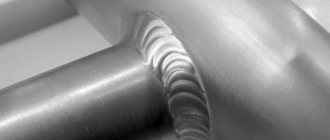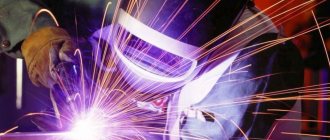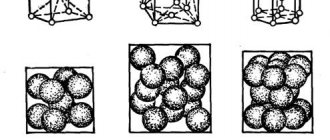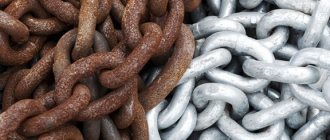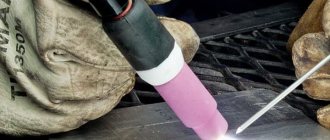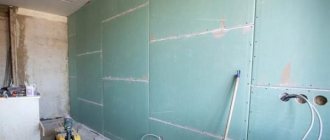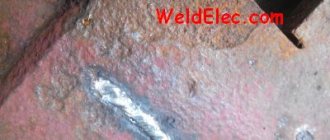12/27/2019 Author: VT-METALL
Issues discussed in the material:
- Why is argon suitable for welding aluminum?
- Preparatory procedures before welding aluminum with argon
- Aluminum argon welding technology
- How to check the quality of aluminum argon welding
Argon welding of aluminum is the only way to obtain a strong connection that meets all the requirements. The problem with welding aluminum is that on its surface there is an inert oxide film that is strong enough to render other welding methods ineffective.
However, it is not enough to simply choose argon welding as a method. It is also necessary to select the right consumables and configure the equipment itself. Read our article about how to get strong seams that do not require processing, what are the ways to check connections.
Peculiarities
Often, when cooking tin bronze, a phenomenon such as the formation of frozen drops is observed. This happens for the reason that fusible fractions float to the surface. Components such as lead and zinc are subject to waste. Their boiling point is lower than that of copper, so natural evaporation occurs.
The type of flame should be controlled. It must be strictly normal. An oxidizing flame burns out the tin, and a carburizing flame causes pores to appear. Acetylene consumption during gas welding should be 70-120 liters per hour per 1 mm of metal sheet thickness. The surface must be in the reduction flame zone, which is 7-10 mm. This is the only way to reduce the degree of tin burnout.
It is recommended to preheat cast bronze parts to a temperature of 450°C degrees. The filler material is BrOTs4-3 or BrOF6.5-0.15 wire. Difficulties in welding aluminum bronze are associated with the formation of an oxide film, which has a high melting point. It can only be dealt with with a special flux. The latter is a substance containing sodium fluoride, sodium chloride, barium chloride and potassium chloride. Silicon bronze, unlike other types of alloys, is weldable well due to the presence of elements such as silicon and manganese.
There are features characteristic of any alloy containing copper. The welder must be aware of these features, because he will certainly encounter certain difficulties. The presence of copper in an alloy determines its physical properties. The thermal conductivity of bronze, like brass, is quite high, as a result of which intensive heat transfer must be taken into account. Rapid crystallization is accompanied by the formation of cracks. Another factor influences here - a high coefficient of thermal expansion. When a metal crystallizes, it “contracts”, resulting in internal stresses.
Bronze is widely used by artists and sculptors in the manufacture of busts or monuments. It is used to make fittings and decorative elements. Welding work must provide not only a reliable connection, but also an aesthetic appearance. The presence of elements such as zinc, tin or lead in alloys largely determines the characteristics of welding work.
The burnout of the listed elements is due to a significant difference in boiling points. After the metal melts in the weld pool, atmospheric oxygen is absorbed. Alloying elements react with it. A film forms on the surface of the bath. At the same time, hydrogen enters the metal, and during crystallization, pores remain. They significantly reduce the quality of the weld.
Expert opinion
Bagrov Viktor Sergeevich
Welder of the highest 6th category. He is considered a master of his craft, knows the intricacies and nuances of the profession.
Welding technology must be strictly followed. Failure to comply with the parameters leads to the appearance of cracks and other defects.
Some problems can be solved by protecting the bath with inert gas. Argon is most often used. All of the above indicates that bronze welding is a rather complex process, so the welder must have certain knowledge and experience.
Types of flammable gases used
Cylinder
Gas welding of non-ferrous metals and carbon steels is most often carried out using acetylene. This is due to the high flame temperature and good combustion heat. Acetylene is a gas with a characteristic odor, which is imparted by the impurities of hydrogen fluoride and hydrogen sulfide present in it. When heated to 500 degrees and at certain concentrations in mixtures with oxygen and air, acetylene becomes explosive. Acetylene is formed by the reaction of calcium carbide with water. Calcium carbide itself is formed by the fusion of burnt lime and coke.
Petroleum and pyrolysis gases can be used as combustibles. They are gas mixtures formed during the thermal decomposition of oil and its products. They are used for welding, cutting and soldering steel parts with a thickness not exceeding 3 mm, and for welding non-ferrous metals and their alloys. Natural gas is a product of the development of gas fields and consists of 93-99% methane.
Balloon
Technical propane and propane-butane mixture are by-products during the extraction and processing of oil and natural petroleum gases. They are used when welding parts with a thickness of up to 6 mm, in some cases - up to 12 mm. Using these gases, you can weld and solder cast iron, non-ferrous metals and alloys, carry out oxygen and oxygen-flux cutting, surfacing, and spraying of plastics.
Welding metal at home using hydrogen has become possible thanks to the development of special electrolysers that can operate from both a two-phase and three-phase home network. In these devices, water is decomposed into oxygen and hydrogen, and in the proportions necessary for the welding process. The size range of produced electrolysers allows us to cover almost all types of gas welding, soldering, surfacing, powder coating, manual and machine oxygen cutting. Devices of varying power allow for micro-welding and micro-soldering, as well as cutting sheet steel with a thickness of about 300 mm.
Preparing for work
Today, welding of bronze, like other alloys containing copper, is carried out in three ways: manual arc welding, argon arc welding and gas welding. Preparatory work is defined for each type of work and does not depend on the choice of welding method. The need to prepare metal surfaces is dictated by the requirements for the weld.
First of all, by mechanical processing it is necessary to form edges that will adjoin each other with the maximum area. Then, using sandpaper or any abrasive tool, you will have to polish the ends until a characteristic golden shine appears. This procedure must be performed in any case, since bronze is quickly covered with a layer of oxide, which can prevent the formation of a high-quality seam.
If it is not possible to carry out mechanical treatment, and the edges are in normal condition, then you can get rid of the oxide using a solution of nitric or hydrochloric acid.
Fundamentals of theoretical training of gas welding specialists
For students studying the course “Gas Welding Technology”, an abstract can be prepared using the following literature:
- Glizmanenko D. A. “Gas welding and cutting of metals”;
- Bagryansky K.V. “Theory of welding processes”;
- Gevorkyan V. G. “Fundamentals of welding.”
For the “Gas Welding” course, the abstract should reflect the following main points:
- purpose, advantages and disadvantages of this type of creation of permanent connections;
- materials necessary for the welding process;
- equipment and apparatus used;
- main technological aspects of gas welding.
Manual arc welding
Bronze welding is most often necessary when carrying out repair work, correcting defects or when surfacing. You can use preheating of the part to 350-450°C degrees, but it should be remembered that at high temperatures the strength of bronze decreases. Manual arc welding is carried out in the lower position. Metal or carbon electrodes are used as consumables.
- When using a metal electrode, a constant welding current of reverse polarity is set.
- Carbon electrodes require straight polarity.
Welding with alternating current is also possible, but for a stable arc the current strength must be significantly higher. If with direct current it is selected based on the calculation of 40 A per 1 mm (electrode diameter), then for alternating current the figure increases to 80 A. The seam is applied continuously, without transverse movements of the electrode.
After welding, cast bronze parts should be annealed at a temperature of 500°C degrees. The rolled product is forged without heating. Phosphor bronze can be arc welded, but it is recommended to use electrodes containing tin, phosphorus and copper. Tin bronze electrodes contain zinc, tin, lead, phosphorus, nickel, iron and copper. Aluminum bronze is welded with copper rods that contain aluminum, manganese and iron. Surfacing of bronze is carried out using bronze electrodes OSTS-5-3-20 or AZH-9-4.
Checking the quality of aluminum argon welding
Products and structures made of aluminum and its alloys are used in mechanical engineering. These are pipelines, tanks, containers, etc. Their reliability and durability are determined by the quality of the welds.
The main methods for monitoring welded joints of aluminum products are ultrasonic flaw detection, X-ray and gamma graphing, visual inspection and measurement, and hydraulic testing with a helium leak detector.
The mechanical properties of welds created with argon must be checked, metallography is carried out - checking the composition and structure of the joint (in the case of performing work that technologically involves thermal control of welding with argon).
The inspection is entrusted to the quality control department employees of the manufacturer of aluminum structures; sometimes the inspection is carried out with the participation of representatives of the customer, since argon welding of aluminum, the price of which is not considered high, is at the same time very responsible.
Methods, parameters and scope of control work are established for each group of products, type of design, and sometimes for specific products, in accordance with the “Control Rules” or technical specifications.
There are certain features in the inspection of products made of aluminum and its alloys, since the material is prone to the formation of pores inside the connection made with argon. In addition to pores, non-fusion can also form in the seam, occurring between the edges and the seam, as well as between the rollers. Searches for non-fusions are difficult because they cannot be detected by X-ray and gamma graphs. Specialists use ultrasound for this purpose when performing flaw detection.
Lack of fusion at the root of the weld is a fairly common defect that occurs when working with a non-consumable electrode during through fusion, when the root of the weld is created on a non-remaining lining. The root of the weld, if it is impossible to gain access to the weld, should be done under the protection of neutral gas. And immediately before welding with argon, it is necessary to scrape the edges to remove the oxide film.
When carrying out multi-layer metal processing, the pores in the lower layers can melt during the process of applying the upper rollers! That is why porosity is not taken into account during the intermediate X-raying of the product.
All welded joints undergo a control procedure for external inspection, except for seams that have external defects - sagging, fistulas at the beginning of the seam, cracks, craters that have not undergone welding and their leads to the base metal, chains of pores and solid meshes, lack of fusion and undercuts.
Argon-arc
This type of welding is fundamentally similar to manual arc welding. The only difference is that the process occurs in a protective gas environment. Argon is heavier than air, so it forms a protective zone through which atmospheric oxygen does not enter the weld pool. Argon arc welding can be carried out with non-consumable tungsten electrodes or consumable electrodes, the role of which is played by rods.
It is argon arc welding that is most often used when working with bronze and brass. This preference is especially given when the metal thickness exceeds 5 mm. Welding productivity is quite high, but the process itself requires the welder to have certain qualifications. An electric arc formed between the metal surface and the electrode partially melts the edges, after which a connection occurs to form a seam. As mentioned above, preliminary preparation of the edges is required.
There are a number of recommendations that allow you to obtain high-quality connections between parts made of copper alloys.
- It is advisable to form the seam in small sections.
- When the process is finalized, the voltage gradually decreases, and then the arc is moved to the side.
- To prevent evaporation of alloying elements, special additives containing silicon, aluminum or boron are used.
Welding bronze and brass is accompanied by the release of toxic substances, so it is carried out in compliance with all possible safety measures. Argon welding has a number of advantages over other types of joints.
- Obtaining an aesthetic seam.
- Economical process.
- There is no need to clean the part from slag.
- For bronze, argon welding is the most preferable.
- Argon welding can be used to fuse parts, restoring their previous shape (for example, when worn).
- It is possible to work with thin sheet metal.
Advantages of argon arc welding of brass parts
It is no coincidence that argon arc welding of brass products, carried out with non-consumable electrodes, is so popular. The advantages of this technological process are as follows.
- To weld brass in an argon environment, neither specially coated electrodes, which are quite expensive, nor flux are required.
- This technology for connecting parts made of brass is one of the cleanest from an environmental point of view.
- Argon welding is characterized by high speed of execution.
- Welds obtained by argon welding are distinguished by high aesthetic characteristics.
- There is no slag crust on welds made using this technique, which must be cleaned.
- The edges of the connected brass parts are reliably protected from the formation of oxide and nitride crusts through the use of inert gas.
- A jet of argon supplied to the welding zone blows out all waste from the technological process.
- This welding method is universal: it can be used to connect both small and large brass products and restore them using the surfacing method.
Gas
Gas welding of copper alloys is used primarily in order to minimize the waste of alloying elements. The welding flame is adjusted so that three zones are clearly distinguished. The metal surface should be on the border of the second and third zones. Working with silicon bronze requires an oxidizing flame. It is obtained by burning a mixture of oxygen and acetylene, if the ratio of the first gas to the second is 1.2. Bronze containing aluminum causes many problems during welding, since a film of aluminum oxide is formed, thickening the contents of the weld pool.
In the absence of preliminary and subsequent heat treatment of the seam, the quality and strength of the joint obtained using gas welding is 85% of the strength of the base metal. A good result can only be obtained after forging the seam. Gas welding requires a lot of experience from the master. At low burner speeds, pores may form in the metal. It is necessary to correctly select the burner power, gas composition, based on the type of bronze and the thickness of the workpiece.
Characteristics of aluminum alloys
The main difference between different series is the alloying element or elements, which, in turn, affect many of the characteristics of the series.
1xxx. This series is not heat treated and has tensile strengths ranging from 10,000 pounds per square inch (PSI) to 27,000 PSI. They are weldable, but due to their narrow melting range, special welding procedures are required to obtain acceptable welds. Their excellent corrosion resistance makes them suitable for use in specialized chemical tanks and piping; their excellent electrical conductivity makes them suitable for busbar applications. They have relatively low mechanical properties and are rarely used for general structural applications. These base alloys are often welded with suitable filler material or with 4xxx filler alloys, depending on the application and performance requirements.
2xxx. This series is heat treatable; tensile strength ranges from 27,000 to 62,000 psi. They contain copper content from 0.7 to 6.8 percent. These are high-strength, high-performance alloys often used in the aerospace and aircraft industries. They have excellent strength over a wide temperature range.
Some are considered non-weldable by arc welding processes due to their susceptibility to hot cracking and stress corrosion cracking; others are successfully arc welded using proper welding procedures. These base materials can often be welded using high-strength 2xxx series filler alloys to match their specifications, but in some cases they can be welded with 4xxx series filler materials containing silicon or a combination of silicon and copper, depending on the application and service requirements.
3xxx. These are non-heat-treatable alloys with tensile strengths ranging from 16,000 to 41,000 psi. The main alloying element is manganese, the content of which ranges from 0.05 to 1.8 percent. They have medium strength, good corrosion resistance, good formability and are suitable for use at elevated temperatures. One of their earliest uses was in pots and pans, and today they are a major component of heat exchangers in vehicles and power plants. Their moderate strength usually makes them unsuitable for use in construction. These base alloys are welded with 1xxx, 4xxx and 5xxx series filler alloys, depending on their specific chemistry and specific application and service requirements.
4xxx. This series includes both heat-treatable and non-heat-treatable alloys. Tensile strength ranges from 25,000 to 55,000 psi. They contain silicon in amounts ranging from 0.6 to 21.5 percent. Silicon lowers the melting point and improves melt flow. These characteristics are desirable for filler materials used for fusion welding and brazing; hence, this series of alloys is predominantly used as filler material. Silicon itself makes aluminum non-heat-treatable; however, the addition of magnesium or copper results in heat treatment of the alloy. Typically, these heat treatable filler alloys are used only when the component being welded must be heat treated after welding.
Filler material 4943 can provide a weld with approximately 25% increased tensile and shear strength in its original condition.
5xxx. This series, without heat treatment, has a tensile strength of 18,000 to 51,000 psi. They contain magnesium additives from 0.2 to 6.2 percent. They have the highest strength among non-heat-treatable alloys. Moreover, these alloys are easily weldable and are therefore used in various fields such as shipbuilding, transportation, pressure vessels, bridges and buildings. Base alloys with less than about 2.5 percent magnesium content are often welded successfully with 5xxx or 4xxx series filler alloys. Base alloy 5052 is generally considered the highest magnesium base alloy that can be welded with a 4xxx series filler alloy. Due to problems associated with eutectic melting and resulting poor mechanical properties after welding, materials in this series at the upper end of the magnesium scale should not be welded with 4xxx series filler materials; For these metals, 5xxx filler alloys are suitable, which usually match the composition of the base alloy.
6xxx. These heat-treatable metals have tensile strengths ranging from 18,000 to 58,000 psi. They contain small amounts of magnesium and silicon - about 1.0 percent. They are widely used in the welding industry, primarily in the form of profiles, and are incorporated into many structural components. Heat treatment of the solution increases their strength. These alloys are susceptible to solidification cracking and for this reason cannot be autogenously arc welded (without filler material). The filler metal dilutes the base material, thereby preventing hot cracking. They are welded with filler materials 4xxx and 5xxx, depending on the application and operating requirements.
7xxx. These heat-treatable alloys have tensile strengths ranging from 32,000 to 88,000 psi. The main alloying element is zinc in an amount from 0.8 to 12.0%. They are composed of some of the strongest aluminum alloys and are often used in high-performance applications such as aircraft, aerospace and sports equipment. Like the 2xxx alloys, this series includes some alloys that are considered unsuitable for arc welding, while others are often welded successfully. Commonly welded alloys in this series, such as 7005, are welded primarily with 5xxx series filler alloys.
Did you know that aluminum makes up 8 percent of the earth's crust? This material part is not only the very soil on which we stand, but also constitutes many of the things that surround us in our daily lives.
Among its many advantages, aluminum has formability, strength, corrosion resistance, light weight, strength, elasticity and energy absorption properties. For example, in semi-trailer manufacturing—an application where light weight is important—making various parts from aluminum rather than mild steel can reduce weight significantly, say by 1,000 pounds. for side wall 187 lbs. for tailgate, 60 lbs. for the cab roof and 30 lbs. on the wheel.
However, this material is not without its problems when it comes to welding. Because of aluminum's low melting point and high thermal conductivity, special care must be taken to prevent burn-through on thin gauges and to ensure adequate melting or penetration on thicker gauges.
When an application requires aluminum, the 6XXX series base material is typically selected due to its versatility for many applications. One particular alloy, 6061-T6, is often used in applications such as shipbuilding, automotive, and trailer construction.
Preparation of titanium and its alloys for welding
The process of manufacturing any semi-finished products and blanks from titanium and its alloys is associated with heat treatment of the metal. This means that the surface of the products contains a dense oxide-nitride film, without the destruction of which welding work will be impossible or ineffective. Therefore, the process of preparing for welding has the following sequence:
- Fitting of workpieces , edging if necessary.
- Mechanical processing (grinding) of prepared edges , as well as adjacent surfaces.
- Chemical treatment of the joint . To dissolve residual films, a mixture of distilled water, hydrochloric acid and sodium fluoride in a ratio of 13:7:1 is used. The exposure time for metal is 5-10 minutes, the required temperature is about 60℃.
- Final processing . Immediately before welding, the joint and adjacent areas (up to 25 mm wide) are cleaned with a metal brush to a characteristic shine, after which they are degreased with alcohol-containing compounds.
Properly carried out preparatory operations minimize the likelihood of cavities in the weld, its cracking or destruction under load, and allow the formation of a homogeneous, stable weld pool.
Specifics of bronze welding
The whole work is complicated due to the large number of impurities contained in bronze. During the welding process, some substances burn out and create a porous seam, which has a very negative effect on the quality of the resulting seam. This disadvantage can be avoided by using welding rods similar in composition to the metal being welded. When bronze is heated to more than 500 degrees, its fragility increases significantly . Therefore, it is necessary to avoid sudden mechanical impacts, and also to minimize the need to move the product to avoid the appearance of cracks.
Finding the best match
When choosing a filler metal for aluminum, you will find that there is no one-size-fits-all solution. The operating conditions and end use of the weldment are decisive factors for the correct selection.
Consult with a trusted filler metal manufacturer or welding equipment supplier for support and to determine the best filler metal classification option.
While one filler metal may provide higher strength or toughness, another may provide better corrosion resistance or ductility. The goal is to select an aluminum alloy that produces a weld that best suits the requirements of the product and its intended use.
